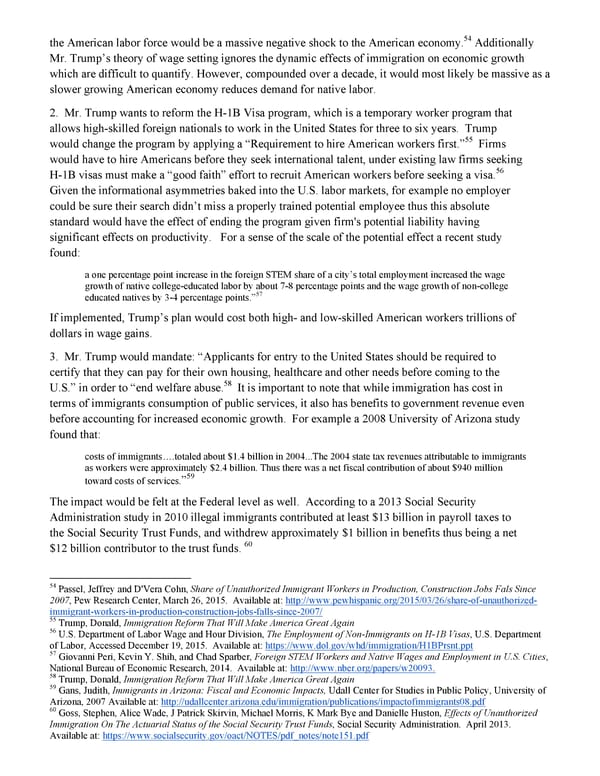54 the American labor force would be a massive negative shock to the American economy. Additionally Mr. Trump’s theory of wage setting ignores the dynamic effects of immigration on economic growth which are difficult to quantify. However, compounded over a decade, it would most likely be massive as a slower growing American economy reduces demand for native labor. 2. Mr. Trump wants to reform the H-1B Visa program, which is a temporary worker program that allows high-skilled foreign nationals to work in the United States for three to six years. Trump 55 would change the program by applying a “Requirement to hire American workers first.” Firms would have to hire Americans before they seek international talent, under existing law firms seeking 56 H-1B visas must make a “good faith” effort to recruit American workers before seeking a visa. Given the informational asymmetries baked into the U.S. labor markets, for example no employer could be sure their search didn’t miss a properly trained potential employee thus this absolute standard would have the effect of ending the program given firm's potential liability having significant effects on productivity. For a sense of the scale of the potential effect a recent study found: a one percentage point increase in the foreign STEM share of a city’s total employment increased the wage growth of native college-educated labor by about 7-8 percentage points and the wage growth of non-college 57 educated natives by 3-4 percentage points.” If implemented, Trump’s plan would cost both high- and low-skilled American workers trillions of dollars in wage gains. 3. Mr. Trump would mandate: “Applicants for entry to the United States should be required to certify that they can pay for their own housing, healthcare and other needs before coming to the 58 U.S.” in order to “end welfare abuse. It is important to note that while immigration has cost in terms of immigrants consumption of public services, it also has benefits to government revenue even before accounting for increased economic growth. For example a 2008 University of Arizona study found that: costs of immigrants….totaled about $1.4 billion in 2004...The 2004 state tax revenues attributable to immigrants as workers were approximately $2.4 billion. Thus there was a net fiscal contribution of about $940 million 59 toward costs of services.” The impact would be felt at the Federal level as well. According to a 2013 Social Security Administration study in 2010 illegal immigrants contributed at least $13 billion in payroll taxes to the Social Security Trust Funds, and withdrew approximately $1 billion in benefits thus being a net 60 $12 billion contributor to the trust funds. 54 Passel, Jeffrey and D'Vera Cohn, Share of Unauthorized Immigrant Workers in Production, Construction Jobs Fals Since 2007, Pew Research Center, March 26, 2015. Available at: http://www.pewhispanic.org/2015/03/26/share-of-unauthorized- immigrant-workers-in-production-construction-jobs-falls-since-2007/ 55 Trump, Donald, Immigration Reform That Will Make America Great Again 56 U.S. Department of Labor Wage and Hour Division, The Employment of Non-Immigrants on H-1B Visas, U.S. Department of Labor, Accessed December 19, 2015. Available at: https://www.dol.gov/whd/immigration/H1BPrsnt.ppt 57 Giovanni Peri, Kevin Y. Shih, and Chad Sparber, Foreign STEM Workers and Native Wages and Employment in U.S. Cities, National Bureau of Economic Research, 2014. Available at: http://www.nber.org/papers/w20093. 58 Trump, Donald, Immigration Reform That Will Make America Great Again 59 Gans, Judith, Immigrants in Arizona: Fiscal and Economic Impacts, Udall Center for Studies in Public Policy, University of Arizona, 2007 Available at: http://udallcenter.arizona.edu/immigration/publications/impactofimmigrants08.pdf 60 Goss, Stephen, Alice Wade, J Patrick Skirvin, Michael Morris, K Mark Bye and Danielle Huston, Effects of Unauthorized Immigration On The Actuarial Status of the Social Security Trust Funds, Social Security Administration. April 2013. Available at: https://www.socialsecurity.gov/oact/NOTES/pdf_notes/note151.pdf
 THE $900 BILLION QUESTION: ILLEGAL IMMIGRATION Page 13 Page 15
THE $900 BILLION QUESTION: ILLEGAL IMMIGRATION Page 13 Page 15